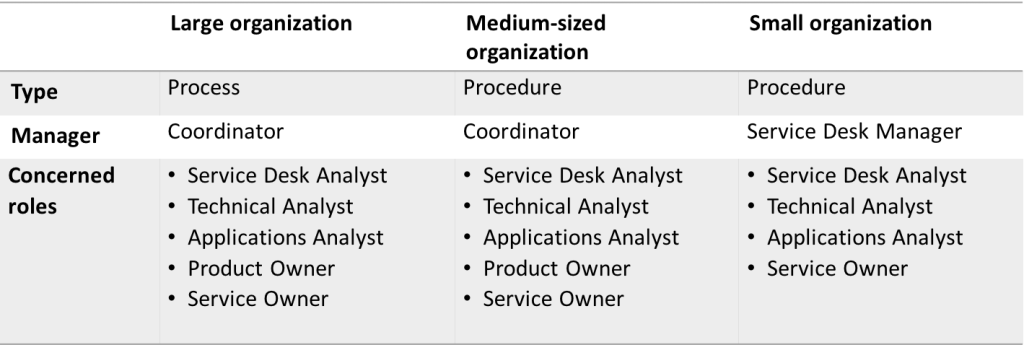Everything that will have to be in operation for a substantial period of time needs to be maintained. Most organizations call this preventive maintenance activity. Within IT organizations, these are tasks which are easily given less priority when there is a lot to do. On many occasions, there is also no documentation of what should be done or how to do it. In the best case, there is a technical analyst responsible who knows what to do and performs the activities when there is time. On the business side, maintenance is usually a much higher priority, regardless of whether it involves machinery in a production line or technical equipment that is required for a particular operation. There is a clear and direct link between equipment not functioning and the business grinding to a halt.
At the same time, businesses are becoming more and more dependent on IT, which means that the preventive maintenance of, for example the infrastructure, should be as important as it is for the technical equipment in the business’s production process.
However, as it is not viewed as equally important, these tasks within the IT organization are not documented as thoroughly. Neither are they timetabled, which means that no-one actually knows the extent of resources required simply to maintain the IT environment that already exists.
The Operational Maintenance process has the function of highlighting the maintenance the IT department performs so that it clearly set out which activities are required, how long they take and how much they cost.

Purpose
The main purpose of Operational Maintenance is to increase the quality of the services that are delivered to the business through performing the necessary preventive maintenance activities in a controlled way in order to maintain the agreed level.
The purpose is also to have control over the amount of activities and the resources required to maintain the current IT environment.
Scope
Operational Maintenance comprises the products and components included in the IT environment. Preventive activities should be defined and documented with a procedure for implementation. Examples of preventive maintenance activities can be:
- Checking logs and alarms (that did not generate an incident)
- Checking that automatic runs are implemented
- Testing restore and redundancy
- Checking and refilling consumables
- Checking documentation
- Producing reports
- Performing updates to operating systems and security programs
Value for the business
Preventive maintenance extends the service life of the IT environment, thus lowering the total cost of the IT services. Operational Maintenance is documented as procedures so that more resources can perform them. This means that key resources can be free for activities which provide more benefit for the business.
Activities
As the Coordination process manages the specific operational issue when it is registered, this process only contains the activities needed to produce and maintain the procedures which constitute the basis for the operational issue.
The following activities are included in Operational Maintenance:
New product – New products and components which are added in the IT environment are defined in the service catalogue. Documentation of associated Operational Maintenance usually takes place in Service Design or in the Release Management process. The activity within Operational Maintenance is to ensure that this is performed, and also to assist with templates and procedures.
Define maintenance activities – Check with the supplier of the new product or component in order to identify which preventive maintenance activities are required.
Document – Document the activities in such a way that all resources with sufficient expertise are able to perform the operational task.
Register task – Register a new recurrent task linked to the procedure, which can subsequently be managed by the Coordination process.
Evaluate – Evaluate completed Operational Maintenance. Check whether there are any incidents registered as a result of an operational task or incidents which it should have been possible to avoid through better preventive maintenance. Also check whether there is relevant new information from the supplier.
Register proposal for improvement – All proposed improvements identified should be managed via the Continual Service Improvement process.

Documentation
The following documentation should be available within the framework of Operational Maintenance:
- Procedure for each operational task
- Templates for documenting Operational Maintenance
Relationships with other processes and functions
Operational Maintenance has links to many other processes. The most common are listed here:

Trigger
Operational Maintenance is triggered through:
- A recurrent timetabled activity
- A new product or component which should be designed or deployed
Input
The following inputs are needed for Operational Maintenance:
- Documentation of the product or service
- Information from suppliers
Output
The following outputs are generated by Operational Maintenance:
- Stable IT environment
- Operational Maintenance performed
- Proposals for improvement
- Statistics for Operational Maintenance and workload
Measurement
This is how Operational Maintenance can be measured:
- Time for maintenance activities as a percentage of total time available in the organization
- Number of assignments not completed in planned time
- The number of incidents generated by Operational Maintenance
- The percentage of activities which can only be performed by a specific person
- Average cost per activity
Challenges
It can sometimes be difficult to motivate technical analysts to write procedures for Operational Maintenance. Above all where they are always performed by the same resource anyway. The purpose of Operational Maintenance is not simply that the implementation is documented, but also that the time taken is registered so that the IT organization’s total workload can be measured. Operational Maintenance is moreover one of the prerequisites for the coordination process to function.
In addition, the following elements need particular attention when implementing the process:
- Don’t make the documentation too extensive, it should be written by technical analysts for technical analysts
- An IT environment usually contains hundreds of products and components. Where applicable, Operational Maintenance can be documented in groups. For example, all servers of the same kind and level of operating system can be grouped into one operational task

